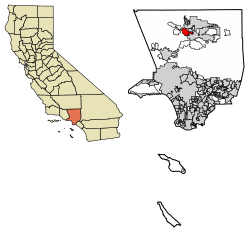Leona Valley, California | |
|---|---|
 Location of Leona Valley in Los Angeles County, California. | |
| Coordinates: 34°37′6″N118°17′14″W / 34.61833°N 118.28722°W | |
| Country | |
| State | |
| County | |
| Area | |
• Total | 18.620 sq mi (48.226 km2) |
| • Land | 18.593 sq mi (48.155 km2) |
| • Water | 0.027 sq mi (0.071 km2) 0.15% |
| Elevation | 3,491 ft (1,064 m) |
| Population | |
• Total | 1,555 |
| • Density | 83.63/sq mi (32.29/km2) |
| Time zone | UTC-8 (Pacific (PST)) |
| • Summer (DST) | UTC-7 (PDT) |
| ZIP codes | 93551 |
| Area code | 661 |
| FIPS code | 06-41208 |
| GNIS feature ID | 2583056 |
| U.S. Geological Survey Geographic Names Information System: Leona Valley, California | |
Leona Valley (Leona, Spanish for "Lioness") is a census-designated place [2] located in the geographic Leona Valley of northern Los Angeles County, California, in the transition between the Sierra Pelona Mountains and Mojave Desert, just west of Palmdale and the Antelope Valley. The population was 1,555 at the 2020 census.
Contents
- Geography
- History
- Demographics
- 2020 census
- Viticulture
- Government and infrastructure
- References
- External links
Leona Valley is best known for its agriculture, particularly cherries and wine grapes. The town of Leona Valley holds its annual Leona Valley Cherry Festival in honor of its agricultural heritage.


